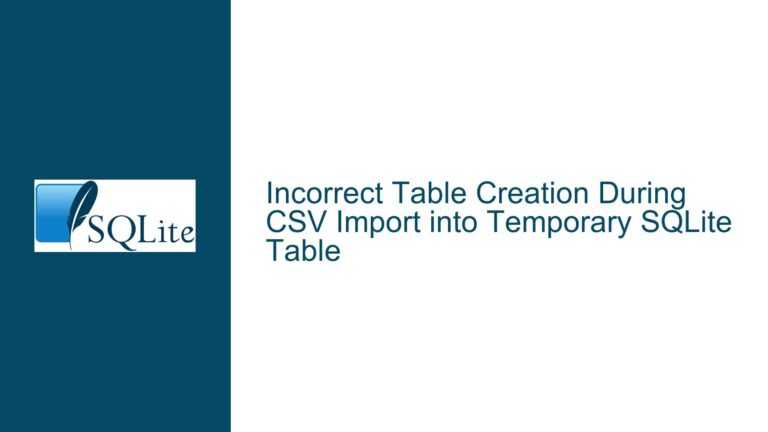Efficiently Inserting Parent-Child Relationships in SQLite
Understanding the Parent-Child Relationship Insertion Problem
When working with relational databases, particularly SQLite, one common task is inserting records that have a parent-child relationship. This scenario often arises when you have a table representing a parent entity and another table representing child entities that reference the parent. The challenge lies in ensuring that the child records correctly reference the parent record, especially when both are being inserted simultaneously.
In SQLite, the typical approach involves inserting the parent record first, retrieving its auto-generated primary key (usually an INTEGER PRIMARY KEY), and then using that key to insert the child records. However, this process can become cumbersome, especially when dealing with complex schemas or multiple parent-child relationships. The primary issue is that SQLite does not natively support a straightforward way to insert both parent and child records in a single, elegant statement without resorting to multiple queries or external programming logic.
The problem is further compounded when the schema requires multiple fields to be queried or when the parent record might already exist, necessitating checks to avoid duplicate entries. This leads to verbose and repetitive SQL code, which can be difficult to maintain and understand. The goal is to find a more efficient and readable way to handle these insertions while maintaining data integrity and avoiding potential pitfalls such as deadlocks or race conditions.
Exploring the Causes of Complexity in Parent-Child Insertions
The complexity of inserting parent-child relationships in SQLite stems from several factors. First, SQLite’s design as a lightweight, file-based database means it lacks some of the more advanced features found in larger database systems, such as stored procedures or complex transactional control. This limitation forces developers to handle many tasks, like managing relationships between tables, manually.
Second, the absence of a built-in mechanism to return the primary key of a newly inserted record directly within a single SQL statement complicates the process. While last_insert_rowid() can be used to retrieve the last inserted row’s ID, it is not always practical, especially when dealing with multiple inserts or when the parent record might already exist. This leads to the need for additional queries to fetch the parent ID, which can be inefficient and error-prone.
Third, the lack of support for certain SQL features, such as INSERT ... RETURNING as a Common Table Expression (CTE), further limits the options for simplifying the insertion process. This forces developers to either use multiple statements or rely on external programming languages to manage the insertion logic, which can be less efficient and more complex to implement.
Finally, the need to handle potential concurrency issues, such as deadlocks or race conditions, adds another layer of complexity. Ensuring that the parent record is inserted and locked before inserting the child records requires careful transaction management, which can be difficult to achieve with simple SQL statements alone.
Step-by-Step Solutions for Efficient Parent-Child Insertions
To address the challenges of inserting parent-child relationships in SQLite, several approaches can be employed, each with its own advantages and trade-offs. Below, we explore these methods in detail, providing a comprehensive guide to implementing them effectively.
1. Using last_insert_rowid() with Explicit Transactions
The most straightforward approach is to use SQLite’s last_insert_rowid() function in conjunction with explicit transactions. This method involves starting a transaction, inserting the parent record, retrieving the parent ID using last_insert_rowid(), and then inserting the child records using the retrieved parent ID. This ensures that the entire operation is atomic, preventing race conditions and ensuring data integrity.
BEGIN IMMEDIATE;
INSERT INTO parent (value) VALUES ('test_parent');
INSERT INTO child (ref_a, value) VALUES (last_insert_rowid(), 'child1');
INSERT INTO child (ref_a, value) VALUES (last_insert_rowid(), 'child2');
COMMIT;
This approach is simple and effective but requires that the parent record is always inserted before the child records. It also assumes that the parent record does not already exist, which may not always be the case.
2. Handling Existing Parent Records with INSERT OR IGNORE
In scenarios where the parent record might already exist, the INSERT OR IGNORE statement can be used to attempt the insertion without causing an error if the record already exists. This is particularly useful when the parent table has a unique constraint on a specific column, such as a name or identifier.
BEGIN IMMEDIATE;
INSERT OR IGNORE INTO parent (value) VALUES ('test_parent');
SELECT id FROM parent WHERE value = 'test_parent';
INSERT INTO child (ref_a, value) VALUES (?, 'child1');
INSERT INTO child (ref_a, value) VALUES (?, 'child2');
COMMIT;
In this example, the INSERT OR IGNORE statement ensures that the parent record is either inserted or ignored if it already exists. The subsequent SELECT statement retrieves the parent ID, which is then used to insert the child records. This approach is more robust but requires additional queries to fetch the parent ID.
3. Leveraging Views and Triggers for Simplified Insertions
For more complex scenarios, particularly when dealing with multiple parent-child relationships or when the insertion logic needs to be reused across different parts of an application, views and triggers can be employed to simplify the process. By defining a view that represents the join of the parent and child tables, and then creating INSTEAD OF triggers on that view, you can encapsulate the insertion logic within the database itself.
CREATE TABLE parent (id INTEGER PRIMARY KEY, value TEXT);
CREATE TABLE child (id INTEGER PRIMARY KEY, ref_a INTEGER, value TEXT);
CREATE VIEW parent_child_view AS
SELECT parent.id AS parent_id, parent.value AS parent_value, child.id AS child_id, child.value AS child_value
FROM parent
LEFT JOIN child ON parent.id = child.ref_a;
CREATE TRIGGER tr_insert_parent_child INSTEAD OF INSERT ON parent_child_view
FOR EACH ROW
BEGIN
INSERT OR IGNORE INTO parent (value) VALUES (NEW.parent_value);
INSERT INTO child (ref_a, value) VALUES ((SELECT id FROM parent WHERE value = NEW.parent_value), NEW.child_value);
END;
With this setup, inserting records into the parent_child_view view will automatically handle the insertion of both parent and child records, ensuring that the correct relationships are maintained. This approach is particularly useful for complex schemas and can significantly reduce the complexity of the insertion logic in the application code.
4. Using Common Table Expressions (CTEs) for Complex Insertions
For scenarios where multiple parent-child relationships need to be handled in a single operation, Common Table Expressions (CTEs) can be used to factor out the lookups and simplify the insertion logic. While SQLite does not support INSERT ... RETURNING as a CTE, you can still use CTEs to organize the insertion logic and make it more readable.
WITH parent_id AS (
SELECT id FROM parent WHERE value = 'test_parent'
LIMIT 1
),
children AS (
VALUES ('child1'), ('child2')
)
INSERT INTO child (ref_a, value)
SELECT parent_id.id, children.value
FROM parent_id, children;
In this example, the parent_id CTE retrieves the parent ID, and the children CTE defines the child records to be inserted. The final INSERT statement combines the results of these CTEs to insert the child records with the correct parent reference. This approach is particularly useful when dealing with multiple child records and can help reduce the complexity of the insertion logic.
5. Combining Multiple Techniques for Optimal Results
In many cases, the most effective solution involves combining multiple techniques to address the specific requirements of the schema and the insertion logic. For example, you might use INSERT OR IGNORE to handle existing parent records, last_insert_rowid() to retrieve the parent ID, and CTEs to organize the insertion logic for multiple child records.
BEGIN IMMEDIATE;
INSERT OR IGNORE INTO parent (value) VALUES ('test_parent');
WITH parent_id AS (
SELECT id FROM parent WHERE value = 'test_parent'
LIMIT 1
),
children AS (
VALUES ('child1'), ('child2')
)
INSERT INTO child (ref_a, value)
SELECT parent_id.id, children.value
FROM parent_id, children;
COMMIT;
This combined approach ensures that the parent record is either inserted or ignored if it already exists, retrieves the parent ID, and inserts the child records in a single, atomic operation. It provides a balance between simplicity, efficiency, and robustness, making it suitable for a wide range of scenarios.
Conclusion
Inserting parent-child relationships in SQLite can be challenging due to the database’s limitations and the need to ensure data integrity and concurrency control. However, by leveraging techniques such as explicit transactions, INSERT OR IGNORE, views and triggers, and Common Table Expressions, you can simplify the insertion process and make it more efficient and maintainable. Each approach has its own advantages and trade-offs, and the best solution will depend on the specific requirements of your schema and application. By understanding these techniques and how to apply them, you can effectively manage parent-child relationships in SQLite and ensure that your database operations are both efficient and reliable.






